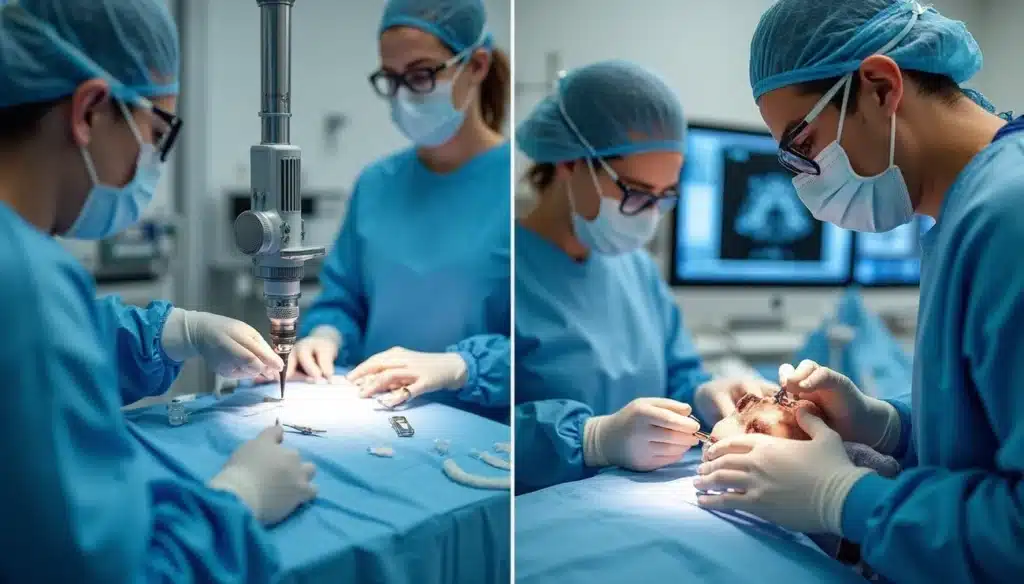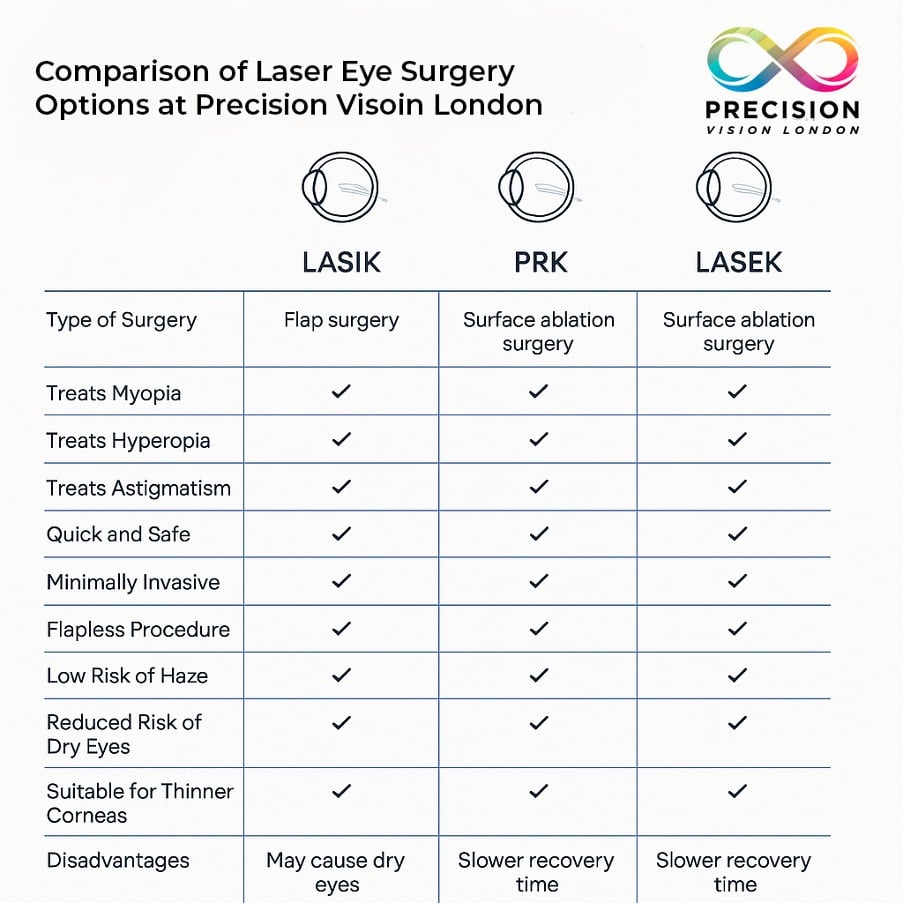Are you weighing your options between LASIK and LASEK eye surgery? You’re in good company. The results speak for themselves – all but one of these patients report satisfaction after LASIK surgery. Both procedures can transform your vision dramatically. About 90% of LASIK patients end up with 20/20 vision, though the recovery time is different by a lot between these popular choices.
LASIK surgery patients usually see better vision within 48 hours. The healing process moves quickly. LASEK surgery’s recovery time takes longer, and the surface skin layer needs about a week to heal properly. This timing makes a real difference when you plan to get back to your daily routine. Most LASIK patients go back to work the next day, while LASEK patients need 4-7 days. The comfort levels vary too. LASIK causes discomfort for just 4-6 hours, but LASEK’s healing process takes more time.
This piece gets into the main differences between these procedures. You’ll find everything you need to know about which option fits your lifestyle, eye condition and priorities better. We cover all aspects – from how each procedure works to the healing milestones that help you make the right choice for your vision correction experience.

LASIK vs LASEK Procedure: What Sets Them Apart
LASIK and LASEK eye surgery fix vision by reshaping the cornea. These procedures work differently to access and reshape this key part of your eye.
Corneal Flap Creation: LASIK vs LASEK Surface Treatment
The biggest difference between these procedures shows up in how surgeons work with your cornea. A surgeon doing LASIK eye surgery creates a thin protective flap in the cornea with a femtosecond laser. The laser makes a precise 3D pattern of tiny gas bubbles inside the corneal tissue. The surgeon lifts this hinged layer and reshapes the tissue underneath. Then the flap goes back in place without needing stitches.
LASEK eye surgery takes a different approach. The surgeon puts an alcohol solution on the eye’s surface to loosen the thin epithelial layer – your cornea’s outer skin. This layer gets gently brushed aside instead of being cut. After the treatment, this layer goes back in place and works like a natural bandage while you heal.
Laser Type and Application Differences
LASIK needs two different lasers. The femtosecond laser makes the protective flap first. Then an excimer laser removes a lens-shaped piece of tissue to reshape the cornea underneath. This two-laser method lets surgeons reshape the cornea precisely while keeping most of the epithelial layer intact.
LASEK is simpler and needs just one laser—the excimer laser—to reshape the corneal tissue. The procedure skips flap creation and focuses on reshaping the cornea after moving the epithelium. TransPRK, a newer type of LASEK, uses a “no-touch” method where laser light works directly on your eye’s surface without removing the surface layer manually.
Surgical Duration and Anaesthesia Use
Both procedures are quick but take different amounts of time. Your LASIK surgery should take about 15 minutes for both eyes. You might feel brief pressure when the laser creates your corneal flap. LASEK moves even faster, usually taking 10 minutes for both eyes. TransPRK can be the quickest option, with both eyes done in under 10 minutes.
These procedures use numbing eye drops instead of general anaesthesia. The drops make your cornea completely numb so you stay comfortable throughout. The laser reshaping part happens quickly—taking less than 15 seconds in LASIK and under a minute in LASEK or TransPRK.
You’ll lie down during either procedure, and a small spring clip keeps your eyes from blinking. While these procedures share some similarities, their different approaches lead to unique recovery experiences and work better for different patients.
Recovery Timeline Comparison: LASIK vs LASEK
The recovery experience stands out as one of the most striking differences between LASIK and LASEK eye surgeries. Your choice between these procedures will substantially affect how soon you can get back to your normal activities.

Initial Healing: 24 Hours vs 5–7 Days
These procedures show dramatic differences in immediate recovery periods. The corneal flap reseals itself within just 24 hours after LASIK surgery. This allows rapid initial healing. Patients usually feel discomfort for only 4-6 hours after the procedure.
LASEK recovery needs more patience. The surface skin layer (epithelium) takes about a week to heal properly. Patients often experience moderate discomfort and become more sensitive to light during the first 24 hours. This longer healing happens because LASEK works directly on the cornea’s surface layer instead of creating a flap.
Return to Work: 1 Day vs 1 Week
Your work commitments play a vital role in selecting between these procedures. LASIK patients can return to work within 24-48 hours of surgery. This makes it perfect for people with demanding schedules. Some patients even resume their normal activities the next day.
LASEK patients usually take about a week off work. This extra recovery time lets the epithelial layer heal properly without daily visual stress. People with flexible schedules might find this longer recovery acceptable, given LASEK’s benefits for certain eye conditions.
Vision Clarity Milestones: Immediate vs Gradual
Vision improvement follows different patterns in these procedures. Many LASIK patients see better almost immediately, often within hours after the procedure. Most patients wake up to clear vision the next morning, though minor fluctuations might occur in the following days.
LASEK patients experience more gradual vision improvement. Vision stays blurry at first, with noticeable improvements typically starting mid-way through the first week. Vision takes several weeks to stabilise, with full clarity developing over 3-6 months.
Post-Op Restrictions and Care Differences
Both procedures require simple precautions at first—limiting screen time and avoiding eye rubbing. LASEK patients also wear a protective contact lens for about 4-5 days. This acts as a bandage during epithelial healing. Swimming should wait for two weeks after either procedure. High-impact or contact sports require at least a month’s wait.
Recovery speed matters. Precision Vision London helps you pick the right procedure—LASIK or LASEK—for your lifestyle and goals. Book a consultation with our expert team today.
Pain and Discomfort During Recovery
LASIK and LASEK procedures create different levels of discomfort that affect how satisfied patients feel and what they can expect during recovery.
LASIK: Mild Irritation and Dryness
LASIK surgery causes brief pain. Patients feel discomfort for just 4-6 hours after the procedure. The sensation feels like wearing uncomfortable contact lenses. Your eyes might feel gritty and sting. They water up and become sensitive to light after the anaesthetic drops wear off (20-30 minutes after the procedure).
Patients often say blinking feels like having sandpaper in their eyes. This discomfort goes away fast, usually within a day. Red eyes are common at first but clear up within a week. Pain decreases faster because the corneal flap made during LASIK reattaches quickly and protects the sensitive tissue underneath.
LASEK: Surface Pain and Light Sensitivity
LASEK recovery brings more discomfort. Patients feel moderate pain for 48-72 hours after surgery as the surface layer (epithelium) grows back. Pain peaks in the first 24 hours. Patients report extreme light sensitivity and a constant gritty feeling.
The complete removal of the epithelial layer in LASEK leaves nerve endings exposed. These symptoms start improving after three days, though some discomfort can last up to a week. Studies show pain can reach a Visual Analogue Scale (VAS) score of 7 without treatment compared to 3 with proper medication.
Use of Bandage Contact Lenses in LASEK
LASEK patients get a special bandage contact lens right after surgery. This therapeutic lens protects the healing cornea from your blinking eyelids. The lens stays in place for 3-4 days and offers several benefits:
- Creates a smooth surface that promotes corneal healing
- Reduces pain and discomfort substantially
- Protects the regenerating epithelial cells
- Reduces friction from blinking
Vision starts improving faster once the lens comes off during your follow-up visit.
Pain Management Options for Both Procedures
Both procedures have good pain control options. Doctors prescribe several medications right after surgery:
- Topical anaesthetic drops for quick relief
- Non-steroidal anti-inflammatory drops (like diclofenac) to reduce pain and swelling
- Prescribed painkillers for extra discomfort
- Preservative-free artificial tears to help with dryness
Research shows topical NSAIDs can lower maximum pain levels from 6.5 to 2.5 compared to placebo treatments. LASEK patients need pain management longer, while LASIK patients rarely need help beyond the first day.
Precision Vision London makes your comfort a priority during recovery. We provide complete aftercare with all needed medications and follow-up appointments to check your healing progress.
Who Heals Faster? Suitability Based on Eye Type
Your eyes’ unique characteristics determine which procedure will give you safer, more effective results. The best choice between LASIK and LASEK eye surgery depends on your eye anatomy, lifestyle, and prescription factors.
Thin Corneas: Why LASEK May Be Safer
Patients with thin corneas (typically less than 490-500 microns) will find LASEK as their best option. LASEK preserves corneal tissue better. LASIK needs enough thickness to create and fit a corneal flap, while LASEK works right on the surface without removing extra tissue.
Patients turned down for laser eye surgery elsewhere often find they qualify for LASEK. We at Precision Vision London suggest LASEK to patients with thin corneas or slightly irregular corneal shapes. This ensures each patient gets the safest procedure that matches their eye anatomy.
Active Lifestyles and Contact Sports Considerations
The surgical approach becomes crucial if you keep playing contact sports or have a physically demanding job. LASEK gives you clear advantages since you won’t have a corneal flap that could shift during impact.
Patients who box, practise martial arts, or do other high-contact activities benefit from LASEK’s flapless technique. LASIK patients must stay away from such activities until their flap heals fully. LASEK patients face fewer restrictions long-term after their initial recovery.
Age and Prescription Stability Factors
Both procedures need patients to be at least 18 years old, with stable prescriptions for at least six months. Most prescriptions stabilise naturally by the mid-to-late twenties. LASEK works better for severe myopia because it can handle higher prescriptions. The procedure shows excellent results for significant short-sightedness as it reshapes more of the central cornea.
Recovery time matters. Let Precision Vision London help you pick the right procedure—LASIK or LASEK—for your lifestyle and goals. Book a consultation with our expert team today.
Cost and Payment Options at Precision Vision London
The cost of vision correction surgery deserves careful thought among other clinical differences between LASIK vs LASEK. Precision Vision London shows clear pricing that helps you make an informed decision.
LASIK and LASEK Pricing: £5,490 for Both Eyes
Precision Vision London prices both LASIK and LASEK procedures at £5,490 for both eyes. This fixed price will give a clear picture without hidden costs or surprise charges during your treatment. You need to pay a deposit of £250 per eye before booking your procedure. This amount comes off your final treatment cost. Specialised treatments like Blended Vision or high prescription corrections cost £2,400 per eye.
What’s Included in the Treatment Package
Precision Vision London’s complete treatment package includes:
- Post-operative eye drops to take home right after surgery
- Follow-up appointments for up to three months
- A five-year commitment to your vision health
- All medications during early recovery
- Enhancement procedures needed within the first year
This all-in-one package removes extra costs for aftercare. You can plan your finances better throughout your vision correction experience.
Original Consultation Fee: £195
A consultation at Precision Vision London costs £195. Expert consultants provide a detailed eye examination and personal advice during this visit. Booking requires a £100 deposit that applies to your treatment cost if you move forward. You get a full refund of this deposit if treatment isn’t right for you. You receive a 50% refund if you qualify but decide not to proceed.
Comparison Table
| Aspect | LASIK | LASEK |
|---|---|---|
| Procedure Duration | 15 minutes (both eyes) | 10 minutes (both eyes) |
| Corneal Access Method | Creates thin protective flap with femtosecond laser | Loosens epithelial layer using alcohol solution |
| Laser Types Used | Two lasers (femtosecond and excimer) | One laser (excimer only) |
| Original Recovery Period | 24 hours | 5-7 days |
| Return to Work | 1-2 days | 4-7 days |
| Post-Op Discomfort | 4-6 hours of mild discomfort | 48-72 hours of moderate pain |
| Vision Improvement | Within 48 hours | Gradual over several weeks |
| Special Post-Op Care | None needed | Protective contact lens for 4-5 days |
| Best Suited For | Normal corneal thickness | Thin corneas (<490-500 microns) |
| Cost at Precision Vision | £5,490 (both eyes) | £5,490 (both eyes) |
| Deposit Required | £250 per eye | £250 per eye |
| Patient Satisfaction | 99% satisfaction rate | Not mentioned |
| Vision Achievement | 90% achieve 20/20 vision | Not mentioned |
Conclusion
Recovery time is a vital factor that sets LASIK and LASEK eye surgery apart. LASIK without doubt offers faster healing, and most patients go back to work within 24-48 hours with minimal discomfort. LASEK patients need more patience and take about a week before they can resume their normal activities.
Your eye’s structure will determine which procedure works best for you. LASEK brings more benefits to patients with thin corneas or those who take part in contact sports, despite taking longer to heal. People with normal corneal thickness who want quick visual improvement might find LASIK’s quick healing more appealing.
Both procedures give excellent results but work on different schedules. LASIK patients see improvements almost right away, while LASEK patients’ vision gets clearer over several weeks. The pain levels also vary – LASIK causes slight irritation for a few hours, while LASEK leads to moderate pain for 2-3 days and needs more pain management.
Note that your corneal thickness, lifestyle needs, and prescription should guide your choice rather than just recovery time. Both procedures cost the same at Precision Vision London—£5,490 for both eyes—with similar deposit requirements and financing options.
The best procedure comes down to your eye’s characteristics and lifestyle. A full consultation with qualified specialists helps make this life-changing decision. Book an appointment at Precision Vision London to see if LASIK’s quick recovery or LASEK’s benefits for specific eye conditions suit your vision correction trip better. Quick recovery matters, but getting the best long-term results for your eye’s anatomy matters more.
Key Takeaways
Understanding the recovery differences between LASIK and LASEK helps you choose the right vision correction procedure for your lifestyle and eye anatomy.
- LASIK offers dramatically faster recovery with patients returning to work within 1-2 days, whilst LASEK requires approximately one week off work for proper healing.
- LASIK causes only 4-6 hours of mild discomfort, whereas LASEK involves 48-72 hours of moderate pain requiring protective contact lenses and stronger pain management.
- Patients with thin corneas or those in contact sports should choose LASEK for safety, whilst those seeking immediate results may prefer LASIK’s rapid vision improvement.
- Both procedures cost £5,490 for both eyes at Precision Vision London, with identical financing options making cost irrelevant to your decision-making process.
- LASIK delivers near-immediate vision clarity within 48 hours, whilst LASEK provides gradual improvement over several weeks, requiring more patience during recovery.
The key is matching the procedure to your specific eye anatomy and lifestyle demands rather than focusing solely on recovery speed, as both achieve excellent long-term results when properly selected.
FAQs
Q1. What is the recovery time difference between LASIK and LASEK? LASIK offers a significantly faster recovery, with most patients returning to work within 1-2 days. LASEK, on the other hand, requires about a week of recovery time before resuming normal activities.
Q2. How does the pain experience differ between LASIK and LASEK? LASIK patients typically experience only 4-6 hours of mild discomfort post-surgery. LASEK patients, however, may face moderate pain for 48-72 hours, requiring more extensive pain management and the use of protective contact lenses.
Q3. Which procedure is better suited for people with thin corneas? LASEK is generally recommended for patients with thin corneas (less than 490-500 microns). It preserves more corneal tissue as it doesn’t require creating a flap, making it a safer option for those with this eye characteristic.
Q4. How quickly does vision improve after each procedure? LASIK patients often notice significant vision improvement within 48 hours of the procedure. LASEK patients experience more gradual improvement, with vision clarity developing over several weeks.
Q5. Is there a cost difference between LASIK and LASEK at Precision Vision London? No, both LASIK and LASEK procedures are priced identically at £5,490 for both eyes at Precision Vision London. The choice between the two should be based on individual eye characteristics and lifestyle needs rather than cost.
Authors & Reviewer
-
 Olivia: Author
Olivia: AuthorHi, I'm Olivia, a passionate writer specialising in eye care, vision health, and the latest advancements in optometry. I strive to craft informative and engaging articles that help readers make informed decisions about their eye health. With a keen eye for detail and a commitment to delivering accurate, research-backed content, I aim to educate and inspire through every piece I write.
-
 Dr. CT Pillai: Reviewer
Dr. CT Pillai: ReviewerDr. CT Pillai is a globally recognised ophthalmologist with over 30 years of experience, specialising in refractive surgery and general ophthalmology. Renowned for performing over 50,000 successful laser procedures.

